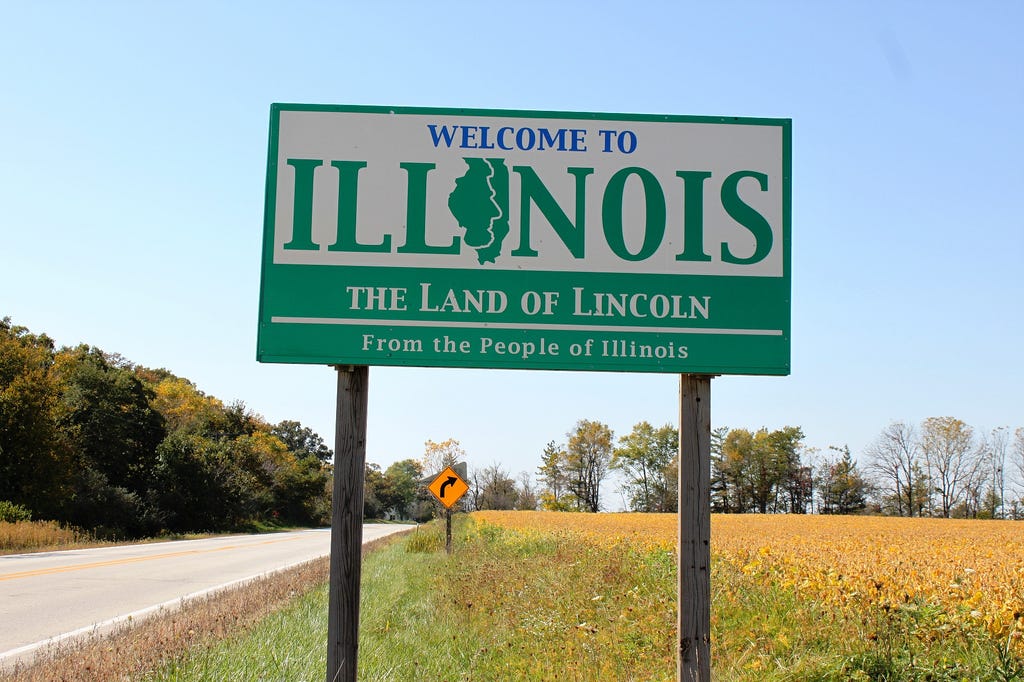Illinois is a low-outmigration state, and other things you probably didn’t know about people moving in and out of the Land of Lincoln

OZinOZ / flickr
In 2015, about 210,000 Americans moved into Illinois, and about 335,000 Illinoisans moved out of the state. The difference — a net loss of about 125,000 people — became one data point in a growing narrative about the “shrinking” of Illinois. For many people, Illinois’ net outmigration has become a leading indicator of the state’s political dysfunction, cited by observers to justify policy reforms on both the left and the right. The release earlier this year of Census figures for 2016, which showed a similar pattern, set of another spate of similar articles.
But while there’s no denying that the top-level numbers are troubling, the tight focus on just one measure of migration — domestic net migration statewide— has obscured a lot of other important patterns that we might learn from.
For example, close to a third of Illinois’ net domestic migration is eliminated by including immigration from foreign countries. Even more striking, focusing only on negative net migration ignores the roughly 300,000 people who have chosen to move to Illinois in each of the last several years, whose decisions about where to locate in the state might shed some light on what Illinois ought to be doing more of. And looking only on statewide migration — with a few zoom-ins to isolated counties — misses how dramatically different the migration picture is from one part of the state to another.
The rest of this post is an FAQ of sorts that seeks to explain Illinois’ migration situation beyond just the hand-wringing headlines.

Randy von Liski / flickr
Okay, more Americans are moving out of Illinois than into it — is that a new problem?
Nope. A recent report from KDM Consulting found that Illinois has had net negative domestic migration for close to a century: with the exception of a one-year blip in 1947, the last time more Americans moved into the state than out of it was 1920.
Partly, that result is baked into the choice to measure domestic migration. Illinois, like New York, California, and other traditional ports of entry, receives lots and lots of immigrants from abroad. Those people get counted as international in-migrants when they move to the state, but domestic out-migrants when they decide to move from, say, Illinois to Massachusetts. In other words, they don’t make the state look better when they move in, but they make it look worse when they move out. In Illinois’ case, including international immigration offsets about a third of the negative domestic migration.
To get the fuller picture — and because attracting international immigrants has been a crucial part of Illinois’ economic and social health for its entire history — for the rest of this post, we will include international immigration in our figures unless otherwise noted.

Anthony Auston / flickr
So does that mean this is a bunch of hubbub about nothing?
No, there really is a problem. While Illinois has had net negative migration for a long time, things have become decidedly worse in the last several years.
To be fair, some of this change was expected, as people began moving again after hunkering down during the economic insecurity of the 2008 recession.
But Census figures suggest that around 2014, Illinois’ net outmigration numbers suddenly jumped far above recent “normal” levels. In the years between the 2001 and 2008 recessions, Illinois lost, on average, a little over 35,000 people to migration annually. But in 2014, that number reached more than 66,000 people —close to double the pre-recession average — and grew to 83,000 in 2016. Over a decade, the 2016 level would reduce Illinois’ population by close to half a million people, compared to the old “normal.”

Jimmy Emerson / flickr
Are different parts of the state seeing different trends?
In a word: yes.
Historically, Chicago’s suburban collar counties have been the migration powerhouse of the state, hoovering up people from across the country and the world, while relatively few of those suburbanites ended up leaving. Cook County, meanwhile, saw huge net out-migration, as city dwellers moved to the suburbs. And the rest of the state hovered right around the break-even point.
The 2008 recession totally scrambled that old dynamic:
- The suburban counties, which since the 1990s had been gaining 10 or more new migrants for every 1,000 residents, suddenly fell into the red, losing more movers than they gained by 2010.
- Cook County, meanwhile, which just before the recession had seen a net loss of 13 migrants per 1,000 residents, improved dramatically. While it never hit positive territory, by 2011, it was actually seeing less net outmigration than the collar counties — a complete reversal of the usual pattern.
- The rest of Illinois, meanwhile, remained roughly the same as it had been through the worst of the recession.
Since the recovery, things have not returned to normal. The suburbs have remained stuck at negative migration rates close to their mid-recession lows. Cook County’s migration figures are falling deeper into the red — once again below the collar counties, but still significantly better than their pre-recession levels. And the rest of the state, for its part, has actually seen a slow decline.
“The rest of the state” includes everything from Rockford to Carbondale. Can you be more specific?
Sure! Here’s a map of the change in all Illinois counties:
Looking at six of the largest downstate metropolitan areas also shows how much variation has gone into the broad trend of worsening net migration figures since the 2000s. The Quad Cities have had consistently negative net migration since the 1990s; Rockford and Bloomington, on the other hand, had strongly positive net migration until the post-recession era.

Jimmy Emerson / flickr
Do any patterns stand out in downstate counties?
You could probably match migration patterns to any number of demographic or economic variables. But one thing that stood out to us was the presence of public universities.
As you can see, since the 2000s, downstate counties with public universities have seen notably stronger migration than other downstate counties, netting about two additional migrants per 1,000 residents over that period. But they haven’t been immune to the overall pattern of declining downstate migration.
So why are so many people leaving Illinois?
Here’s the thing: Illinoisans aren’t actually more likely to leave their state than residents of other parts of the country.
That’s because “net migration” — what we’ve been talking about this whole time — is made up of two pieces of gross migration: Gross in-migration (all the people who move to a place) and gross out-migration (all the people who leave). Net migration is just the difference between those two numbers.
So bad net migration numbers can be the result of an unusually high number of people leaving, or an unusually low number of people moving in. And in the case of Illinois, it appears to mostly be the second.
In per capita terms, Illinois’ gross out-migration rate ranks just 29th out of the 50 states and the District of Columbia. In other words, Illinois residents are actually less likely to move out than are residents of the median state.
But things don’t look so good when it comes to gross in-migration. Adjusted for population, Illinois attracts fewer newcomers than all but two other states: New York and Michigan.
That means Illinois’ migration problems are mostly about how few people come here, not how many people leave.

Okay, but some people do move to Illinois. Where do they go?
The vast majority, or 70 percent, come to the Chicago metropolitan area: about 44 percent moved to Cook County in 2014, and 26 percent to the collar counties. Champaign County, home to the University of Illinois, comes in after that, at a distant 4 percent.
How much does taxes have to do with it?
It’s common to hear that people leaving Illinois — or avoiding it by not moving here — do so because of high taxes. But generally, researchers find that taxes are relatively low priority factors when people decide to move, falling far below things like being close to family, job markets, and housing costs, which often make a bigger difference in total cost of living than state and local taxes.
In Illinois, some commentators have pointed to a Southern Illinois University poll from October 2016 that found respondents who wished to leave the state cited taxes more than any other single issue. But even in that poll, 73 percent of respondents named an issue other than taxes as the reason for leaving.
On top of that, as you’ve seen, the evidence shows that Illinois’ migration problem isn’t so much about people in the state leaving, as people out of the state choosing not to move here.
Another way of looking at this issue, though, is by examining the relationship between local property taxes and migration in different parts of the state. If taxes are a big reason that people are avoiding Illinois, you’d expect to see that counties with lower property taxes have stronger net migration numbers than counties with higher property taxes.
But in fact, there appears to be barely any relationship between property tax burden and net migration rates in Illinois counties.
And if you look at gross migration, the figures are even more striking. As local property tax burdens increase, gross migration per capita also increases. Counties with property tax burdens more than twice the state median see more than 60 percent more in-migrants per capita than counties with property tax burdens below the state median.
Okay, enough numbers. So what? What have we learned?
Every year, more people choose to leave Illinois than choose to move to it. That fact has taken on a lot of weight as partisans on all sides insist the only way to “stop the bleeding” is to adopt their preferred policies.
But what seems like a straightforward problem is actually much more complicated. Illinois has had net negative domestic migration for nearly a century. There has been a significant deterioration recently, but it seems to be driven by significant regional divergences: The Chicago suburbs, long a migration powerhouse, are no longer, even as Chicago and the Cook suburbs are performing somewhat better than they did in previous decades.
A closer look also shows that what has been interpreted as a problem of too many people leaving is actually a problem of too few people arriving. Illinois does not have an unusually high out-migration rate: it has an unusually low in-migration rate. While it’s of course worth trying to keep people from leaving the state, Illinois’ migration problem won’t really be addressed until we figure out why people don’t want to come here.
And while taxes are a common go-to scapegoat for net negative migration numbers, there is little empirical evidence to suggest that they are what’s driving Illinois’ migration problem.
What is, then? That’s still up for debate. But hopefully this post will help those of us who care about the future of Illinois ask better questions to get the answers we’re looking for.
No comments:
Post a Comment